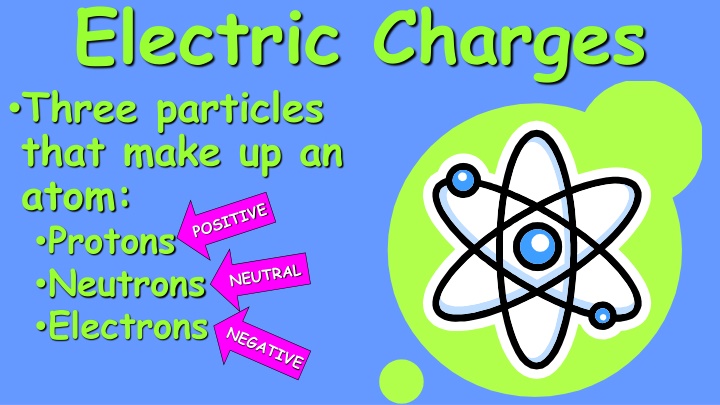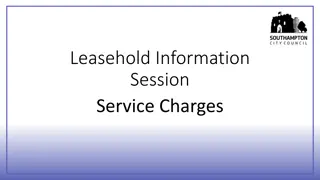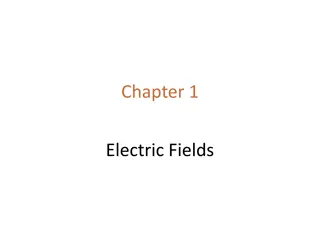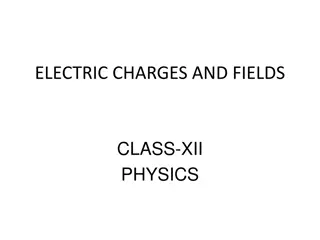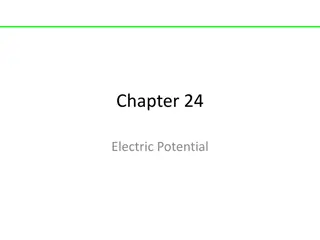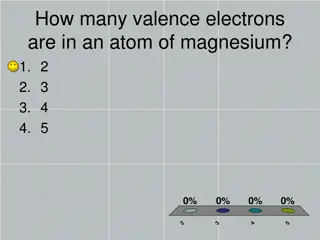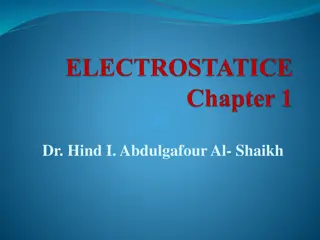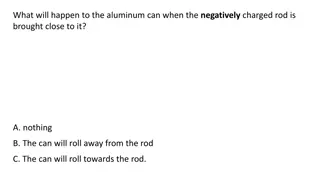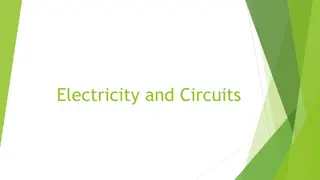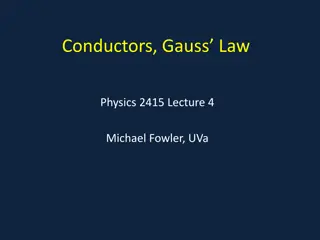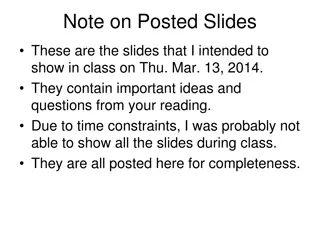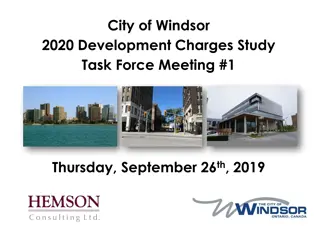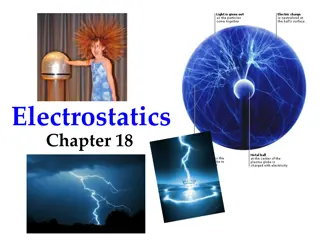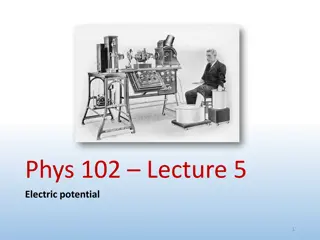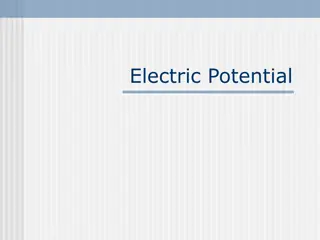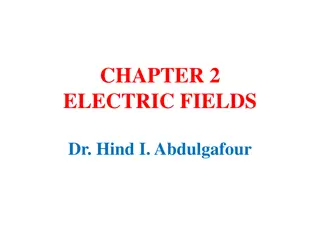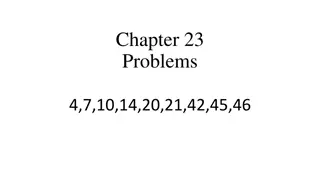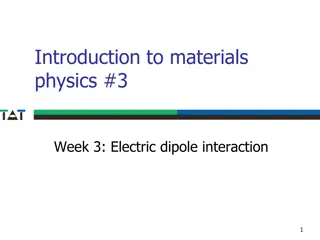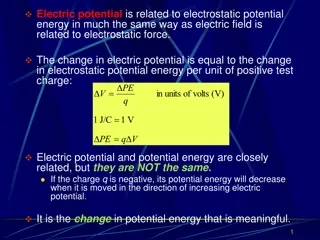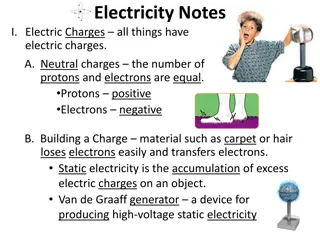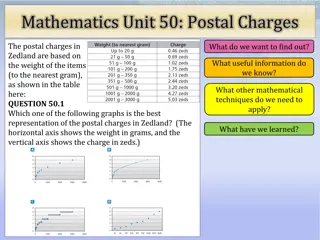Electric Charges
Explore the fundamental concepts of electric charges, the flow of charges, interaction of charges, electric current, potential difference, and the relationship between potential energy and charges. Understand the role of protons, neutrons, and electrons in atoms, the movement of electrons, and how charges interact based on their types. Learn about electric current as the flow of charges in materials and the concept of potential difference in electrical systems.
Download Presentation

Please find below an Image/Link to download the presentation.
The content on the website is provided AS IS for your information and personal use only. It may not be sold, licensed, or shared on other websites without obtaining consent from the author.If you encounter any issues during the download, it is possible that the publisher has removed the file from their server.
You are allowed to download the files provided on this website for personal or commercial use, subject to the condition that they are used lawfully. All files are the property of their respective owners.
The content on the website is provided AS IS for your information and personal use only. It may not be sold, licensed, or shared on other websites without obtaining consent from the author.
E N D
Presentation Transcript
Electric Charges Three particles that make up an atom: Protons Neutrons Electrons
The Flow of Charges Which subatomic particle can move from one object to another? Electrons! What does the addition of electrons do to the charge of an object? The object will become NEGATIVELY charged. What does the removal of electrons do to the charge of an object? The object will become POSITIVELY charged. e- e- e- e- e-
How Charges Interact When two objects with the SAME charge come into contact, they _____________. When two objects with DIFFERENT charges come into contact, they _____________. repel a ttra ct
Electric Current What is an electric current? The continuous flow of electric charges through a material. What is the unit of measurement for current? amperes (A) or amps: the amount of charge flowing past a point in a certain amount of time. e-
Potential Difference So what is Potential Difference? The difference in potential energy between two locations. The difference between a rollercoaster and an electric current is that the potential difference is caused by the difference in electrical charges in two locations, not height.
Potential Difference What s potential energy (PE)? On a roller coaster, where does the car have more potential energy? Can the car move from an area of low PE to high PE without the help of a motor? It s the same for electric current! The charges in a current are like the roller coaster cars. The track is like the wires. The motor that gets the cars to the top of the first hill is like the battery.
Potential Difference Cont. Electric charges will always flow from a region of ___________ potential energy to a region of _________ potential energy. When the charge reaches the negative terminal and enters the battery, it gains electric potential energy as it travels through the battery to the positive terminal. high low e-
Voltage What is it? Another term for potential difference. What unit is used to measure voltage? Volts (V) So in a 9-volt battery, when an electric charge moves from the negative terminal, through the battery, to the positive terminal, how much potential energy does the charge gain? 9 volts! e-
Basic Circuits A circuit is a path through which electricity can flow. Most circuits have three parts: An energy source One or more loads (run by electricity) Conductors (wires) that connect the two
Parts of a Circuit Energy Source A circuit needs an energy source to push a charge through the circuit. Examples? Load a load is a device in a circuit that operates using electrical energy. Examples? Conductor a conductor is a material that allows electrical energy to flow through it easily. What makes a good conductor? Examples?
Parts of a Circuit Continued Resistor a resistor is an object added to a circuit that restricts the flow of electrical energy. Resistors inhibit the flow of electric current by producing a voltage drop when current passes through them. They limit current and cause some electric energy to be given off as heat. Examples? Switch - a switch is a device that is used to control the flow of current through a circuit. A switch works by separating (open) or bringing together (closed) two conductors attached to a circuit.
Circuit Switches Add a switch to your circuit. See what happens when you open and close the switch. On your notes, draw a circuit with an open switch and a closed switch. Indicate whether the light is on or off. When an electric current reaches an open switch, the current _________. This creates an __________ circuit. When an electric current reaches a closed switch, the current _________. This creates a __________ circuit. Why would you want a switch in a circuit? closed stops continues
Types of Circuits Two types of circuits: Series Circuit Provides only one possible path for the flow of current. Parallel Circuit Offers more than one path for the flow of electricity.
Series Circuits In a series circuit, the loads are set up in a series, or line, that requires the current to flow through one load before passing through the next. Create a series circuit using the materials at your table. (the switch is optional) Draw your circuit on your notes sheet. Use arrows to indicate the direction the electric current is traveling.
Series Circuits Continued If you were to disconnect one of the bulbs in your circuit. What happens to the other bulbs? Because there s only one path for the current to follow, a failure or break in any part of the switch will stop the flow of electricity through the entire circuit. Where have you seen this happen before?
Series Circuits Continued Because all of the loads share the same energy source. This means that the current lowers as more loads are added to the circuit. What if the loads were motors? Would they be able to do as much work if they re wired in a series? On your notes, list the disadvantages of using a series circuit.
Parallel Circuits In a parallel circuit, each load has its own path for electricity. Create a parallel circuit using the materials at your table. (the switch is optional) Draw your circuit on your notes sheet. Use arrows to indicate the directions the electric current is traveling.
Parallel Circuits Cont. If you were to disconnect one of the bulbs in your circuit. What would happen to the other bulbs? Because a parallel circuit provides more than one path for electricity, a failure in one part of the circuit will not affect another part of the circuit. Where have you seen this happen before?
Parallel Circuits Cont. When you reconnect your parallel circuit the bulbs are still bright. Even if all bulbs are connected or some are out the brightness is the same. The loads in a parallel circuit do not share current in the way that loads connected in a series will share. Each load connected to a parallel circuit uses the full voltage of the energy source. What if the loads were motors? Would they be able to do as much work if they re wired in a series?
Series VS. Parallel What s the big deal? What happened when you added more loads to a series circuit vs a parallel? Why don t we use Parallel circuits all the time? Which would cause the energy source (battery) to be drained more quickly? Which uses more electric energy?
Dont forget to visit Brain PoP!! https://www.brainpop.com/technology/energytechnology/electriccircuits/ https://www.brainpop.com/technology/energytechnology/currentelectricity/
